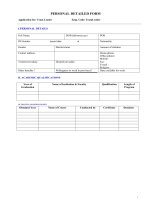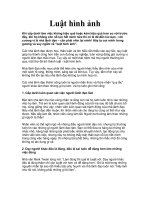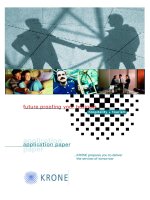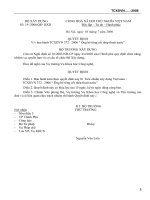Tài liệu Covering Cover Letters ppt
Bạn đang xem bản rút gọn của tài liệu. Xem và tải ngay bản đầy đủ của tài liệu tại đây (109.27 KB, 4 trang )
Covering Cover Letters
By Sue Nowacki and Steve Burt
Why A Cover Letter is More Than Just A Dust Jacket
"Do I really need a cover letter?" We're asked this question a few times every month. We get the
impression that people are hoping we'll say, "No! You don't need a cover letter. Your résumé's great, it
can stand on its own." After putting so much time and effort into their résumé, it's easy to understand why
people might think the cover letter is nothing more than a "dust jacket" for the real article. Just one more
piece of wasted paper that delays getting to the good stuff. What do most cover letters say, after all, but,
"You've got a job, I've got a resume. Hope to hear from you soon."
But the cover letter is more than a way to dress up your résumé. It has a beneficial purpose. If written
well (focusing on how and why your particular skills, experience, achievements and personality can
benefit a specific position and company), your cover letter can encourage your reader to turn to your
résumé with genuine interest.
What the Cover Letter Does that the Résumé Doesn't
While your cover letter acts as an introduction, it can also take your résumé's information one step further
by showing your reader how your history and past achievements can be applied to meet the needs,
concerns, missions, and goals of the company you're targeting. In this way, your cover letter not only
confirms your qualifications for the position, but also indicates that you are the right person for this
company.
In order to present your qualifications in a meaningful way to your specific reader, you need to do some
homework on the company you're targeting. Learning all that you can about a company, knowing what
they're trying to achieve, what their products or services are, who comprises their customers or clientele,
what their strengths and weaknesses are, what their concerns are, who their competitors are, and how
well they're achieving their goals, will not only help you identify ways in which your skills can be directly
applied for the company's benefit, but can also help you determine if this is a company where you want to
work.
In doing your company homework, you may discover an area where your skills or background can make
a substantial, positive difference for the company you're targeting. Nothing will advance your
opportunities faster than finding a couple of flaws or deficits in the way a company manages its
operations and showing how your particular area of expertise can solve this problem in a cost-effective
manner ~ just be careful how you present these flaws. No one wants to hear that they're not doing a
terrific job, but everyone likes to hear, "I have some ideas that could really make this particular effort fly,
and I'd like to talk to you about them."
Knowing that you have something valuable to offer is a great incentive for a recruiter to want to meet you
in person to learn more (the interview).
Getting information on companies of interest has never been easier. The Internet has opened the doors
to information access, from the comfort of your own home (please, don't do this research on your current
employer's computer). Since most companies have Web sites these days (and, by the way, many of
these company sites also post job opportunities), the opportunity to learn what a company is doing, who
their leadership is, who their clientele is, what their products or services are, and what they're hoping to
achieve in the future is just few mouse clicks away. And resource sites such as Hoover's (www.1st-
impact.com/tools.htm) allow you to gain additional information, regardless of whether or not a company
has its own Web site.
Your local library is also a great resource. Tell the Librarian what you're trying to achieve and you may be
surprised by the number of resources available. A few resource guides worth mentioning are: Corporate
Jobs Outlook, Corporate Technology Directory, Directory of Corporate Affiliations, Directory of Leading
Private Companies, and The Almanac of American Employers. Doing a search on the library computer
may turn up additional articles, press releases, or annual reports, all great indicators of what a company
is trying to achieve and how well they're doing.
Once you have a solid understanding of your target, you need to identify how your skills, experiences,
education, achievements, and personal characteristics will meet the needs of the particular company.
One easy way of determining this is by considering what it is about the company that (after having
learned all you can about them) makes you want to work for them. What do you envision yourself doing
for them, for their benefit? How do you see yourself making a difference?
When in my Cover Letter or Résumé Should I State What I'm Hoping to Gain from Employment?
Never.
The simple truth is, at this stage of the game your reader doesn't care about what you want or what
you're hoping to gain from being employed at their company. Right now your reader only cares about
what you can do for them.
You want your reader to act (hopefully by calling you to discuss the position and establish an interview
date ~ or at least to be willing to accept a call you've indicated you'll be making). Later, during the
interview phase, you'll have an opportunity to address how the position fits your needs, but at this point
every effort you make needs to be focused on the needs of the reader, the position, and the company in
question.
The Two Types Of Cover Letters.
There are basically two types of cover letters. One is used in submission to an ad or known position
opening, commonly known as the "standard" cover letter. This type of cover letter is easier to write for an
obvious reason - some of the criteria of the position is being made known through advertisements or
network contacts, thus aiding the writer in knowing what specific criteria and needs the reader wants
addressed. This is also the type of cover letter used when someone is referring you to a company, "John
Doe suggested I contact you regarding. . ." or "It is by John Doe's recommendation that. . ."
The second kind of cover letter is commonly called a "broadcast" cover letter. This type of cover letter is
used when targeting companies of interest but when no known position opening is being made public (or
may not even, at the present time, exist). Although some companies frown on unsolicited résumé
submissions, some position openings are often known long before the position is announced (someone
has just turned in their resignation, a new position is being developed for an emerging need, someone is
going to be retiring, someone is going to be or has just been fired). This is part of what's called the
"hidden job market." Waiting for a position to be advertised simply assures that your résumé will be
placed in competition with hundreds of other equally eager candidates.
Understanding your reader, the position you're targeting, and the company in question is important in all
of your cover letter and résumé submissions, but it's particularly important in the broadcast cover letter.
At least in the standard submission, when applying to an ad or known position opening, you have a
sense of what the reader wants and that they're willing to receive your material. In the unsolicited
submission, it's even more important to make your reader feel that what you have to say and what you
have to offer is worthy of their time and attention.
The Basic Elements of the Cover Letter.
First of all, the layout of your cover letter is as important as the layout of your résumé. Keep in mind that
the first thing your reader will see is your cover letter (okay, it's actually the second thing they'll see,
following your envelope ~ we recommend using a 9x12 white envelope). Your cover letter should
complement your résumé in style, layout, letterhead, print and paper quality. It shouldn't look like it was
simply added to the submission at the last moment, but that it's an integral part of the presentation.
Cover letters normally follow this general outline:
• Your contact information (letterhead): Make certain this is easy to read. When all is said and
done, your contact information is the most important information in the letter.
• Date: It's important to give your reader a submission date, indicating the information's date and
relevant value.
• Name of contact and their title: Get the exact name and correct spelling whenever you can ~ it
will always have a greater impact than an anonymous recipient greeting. Follow this with the
name of company, street address, city, state, and zip code.
• Job title or reference number: Re: ________.
• Dear: Use either exact contact name, Mr./Ms. _____, or Director of Human Resources for Name
of Company. Never use "Dear Sir or Madam," or, worse, "To Whom It May Concern."
• Opening paragraph: Although you may be tempted to come up with an interesting
opening sentence, there's value for your reader in identifying for them the ad or
position to which you're applying at the onset of your letter. Your reader may be
screening résumés for several positions, and including a reference to the position
title and location puts the reader on the right track. Keep this introductory sentence
to the point and brief.
• The second line in your cover letter should be attention grabbing, but avoid
gimmicks. Although you're trying to "sell" your qualifications for the position, you
don't want to come across as an advertisement. This is a professional
correspondence. So, instead, consider the second line a summary of what the
letter's purpose is: "My background in _____, _____, and _______ appears to be a
solid fit for the position of _________. It is with genuine interest that I enclose my
résumé for your review and offer a brief summary of how my skills may benefit
{Name of Company}'s _______ efforts."
• The second paragraph: highlights not only those qualifications listed in your résumé,
but also the extended skills and characteristics you possess that will be of additional
value to your reader and the position and company you're targeting. This second
paragraph also addresses the particular needs, concerns, missions and goals of the
company (as you know them) and how your potential contribution will benefit and
promote these goals (from the company's point of view). This is where you establish
what sets you apart from all other candidates with similar skills sets ~ why you are
the right person for this job at this company. Ultimately, you want your reader to be
able to envision you working for their company and producing valuable results.
• Closing paragraph: This is the only place in the cover letter where you indicate what
you're hoping to gain from this submission: a call and an interview. Avoid using
gimmicks or threats. We've seen cover letters that sound desperate and nearly
threatening, "If I don't hear from you by {date} I'm going to call you." This kind of
statement, even from the most worthy of candidates, can make your reader jump to
the secretarial desk and request that "If Joe Smith calls, take a message and throw
it away." When you call a potential employer, without a stated date, time, or
invitation, you may simply end up irritating them by disrupting their work. Instead,
you want to make your reader feel comfortable in contacting you by your indication
that you're interested and available for contact, at the reader's convenience. It's
perfectly fine to indicate that, with your reader's permission, you'd like to call them
on such-and-such a date at a such-and-such a time to discuss the position, with the
added note that if this time is inconvenient they may leave a message with the
receptionist indicating a time that would be preferable. Make this easy for your
reader.
By the way, if you can't be at your phone waiting for every call (you may wait a long time), consider
purchasing an answering machine, if you don't already have one, or contacting your phone company for
voice mail service on a temporary basis. If you're unreachable, you cannot be interviewed. Record your
message and have a friend call and critique it for you. You want your message to sound professional, be
clear in tone (with no background noise), offer the appropriate identifying information, and be brief.
Something along the lines of the following seems to work very well: "You have reached Joe Smith at 234-
5678. I'm sorry I'm unable to take your call at the moment, but your call is very important to me. Please
leave your name and number and a brief message and I will return your call as soon as possible. Thank
you for calling"
Salary Requirements and Salary History.
Until you interview for a position, chances are you'll have only a limited understanding of the details and
accountabilities of the position. Until you understand the full dimensions and responsibilities of a position,
you can't address appropriate compensation. This lack of information, on both sides, makes salary
negotiation ineffective and premature at this stage of the game.
While it's tempting to include a salary range or expectation ("It will save me from interviewing for jobs that
won't pay me what I need"), doing so limits your opportunities. Most companies will establish a position
budget, but these budgets can be flexible. If you give a range too high or too low before the interview,
however, you've removed your negotiating leverage and possibly the opportunity itself.
For job ads that say "Only those submissions which include salary requirements will be considered," offer
a range rather than a set figure. This will give you some room for negotiation. For other ads that simply
request "salary requirements" with submission, recognize the question without actually answering it:
"Salary is negotiable."
For companies requiring a salary history, create this as a separate document, rather than including the
information in your cover letter or résumé. This document should look the same as your cover letter and
résumé in layout and style, and will follow your résumé's line of information regarding past employment
history. For example:
Title ABC Company, City, State Dates of Service Annual Salary
Other options include indicating beginning salary and ending salary (showing growth and advancement),
or hourly wage.
What to Do After the Cover Letter and Résumé Have Been Sent.
It would be wonderful if every résumé and cover letter submission resulted in a telephone call.
Unfortunately, we live in the real world and it's very competitive out there. Be proactive in your job
search. Be willing to follow up your résumé submissions with a phone call or a note that reiterates your
interest and offers to provide further information if necessary. Your reader may receive hundreds of
résumés, and hearing from you may move your résumé closer to the top of the pile. A good time frame to
follow is that if you've heard nothing in the two weeks following your submission, go ahead and follow up
with a phone call or note. Don't do this by e-mail.
Good luck with your job search!
Sue Nowacki and Steve Burt









